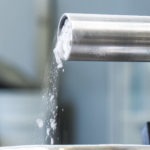Arizona dust according to the current standard ISO 12103-1 in different variants (including quartz-free) and grain sizes (A1, A2, A3, A4) as well as according to the previous standard SAE J726 (fine, coarse).
Arizona dust
We offer Arizona dust according to two different standards. The currently valid ISO 12103-1 as well as the original standard SAE J726. These dusts are available in different variants from ultrafine to coarse:
- ARIZ-TD: “Original” – exact conformance to ISO 12103-1
- ARIZ-KSL: quartz-free variant, particle size distribution according to ISO 12103-1
- ARIZ-ISO: Pure quartz variant, distribution according to ISO 12103-1
A more detailed comparison of these three variants is available for download. All variants according to ISO 12103-1 are offered in the gradations A1 (ultra fine), A2 (fine), A3 (medium) and A4 (coarse). The grade A2 is also used for IP code tests according to ISO 20653 or for filter tests (e.g. ISO 15957 (L2), ISO 29461, ISO 16890).
Numerous test dusts according to national and international standards such as DIN (Germany), EN (Europe), ISO and IEC (worldwide).
International standards
Talc dust according to DIN EN IEC 60529, VDE 0470
For testing degrees of protection provided by enclosures (IP Code).
Test dust according to DIN EN 60068-2-68
For environmental testing: dust and sand according to variant 1 – fine dust, variant 2 – coarse dust and variant 3 – sand.
Test dust according to DIN 40050-9
From mineral components and fly ash – degrees of protection (IP Code), road vehicles, electrical equipment.
Sodium chloride (NaCl) according to DIN EN ISO 9227
Corrosion tests in artificial atmospheres – Salt spray tests.
In addition to pure NaCl, we also offer “Northern salt“, a salt mixture of 95% NaCl, 2.5% MgCl2 and 2.5% CaCl2 (acc. LV 214).
Test dust according to DIN EN IEC 60079-0
Explosive atmospheres – Part 0: Equipment – General requirements: Test dust with very low thermal conductivity (< 0.1 W/m*K).
Albite according to DIN SPEC 4867
Test dust for standardized cleaning test methods for the abrasion resistance of glass coatings for solar applications.
eskal 300 according to DIN EN IEC 60335-2-69
Very fine limestone dust made from naturally pure calcium carbonate. Used e.g. to test electrical devices based on DIN EN IEC 60335-2-69.
Silica sand according DIN 52348
Testing of glass and plastics: wear test – sand trickling method.
Silica sand according DIN EN 12904
Products used for treatment of water intended for human consumption – Silica sand and silica gravel (in parts).
The Military Standard 810 includes several test dusts, such as blowing dust and blowing sand.
MIL-STD 810
Blowing dust
Quartz test dust with a maximum particle size of 150 µm and a mean particle diameter of 20 ± 5 µm. Also corresponds to the test dust “140 mesh silica flour”.
Blowing sand
Quartz test sand with particle sizes between 150 and 850 µm. The exact distribution corresponds to the US Military Standard 810.
Settling dust
Quartz test dust according to MIL-STD 810 with a maximum particle size of 105 µm.
Red China Clay
Synthetically produced test dust mixture from different minerals according to MIL-STD 810.
The ECE standards are an important set of rules of the United Nations Economic Commission for Europe for formulating conditions for the approval of equipment and parts of motor vehicles.
ECE test dusts
Test dust according to ECE R 16
Quartz test dust with a defined particle size distribution for testing seat belts, restraint systems and (ISOFIX) child restraint systems. This test dust is also available in a version without fine quartz dust.
Test dust according to ECE R 45 / R 112 / R 113 / R 123, Appendix 4
Test dusts from different components for testing of headlamps:
2.1.1: for headlamps with the outside lens in glass
2.1.2: for headlamps with the outside lens in plastic material
ECE R 45: Headlamp cleaners
ECE R 112: Asymmetrical headlamps
ECE R 113: Symmetrical headlamps
ECE R 123: Adaptive front-lighting systems (AFS)
Silica sand according to ECE R 112 / R 113 / R 123 Annex 3 Point 1.2 (a)
“Silica sand of hardness of 7 on the Mohs scale, with a grain size between 0 and 0.2 mm and an almost normal distribution […].”
Other standard test dusts such as China dust according to FLTM and dusts according to JIS (Japanese Industrial Standard), VDI or ASTM C150 (Portland cement).
Other standard dusts
Test dusts according to JIS Z 8901
Synthetically manufactured test dusts based on the specifications for Class 1, 2, 3, 7, 8, 9 and 11.
Portland cement according to ASTM C150
Portland cement according to ASTM C150-15 Type I, as defined in many standards (incl. SAE J575).
China dust according to FLTM BZ 106-01
Synthetically produced test dust in the three particle size classes fine (= FLTM BZ 106-01), medium and coarse. Also available as quartz-free variant.
Middle East (ME) test dust according to VDI 3956
Test dust for simulating the adhesion behavior (“soiling”) on the surfaces of solar energy systems (PV modules, CSP reflectors).

